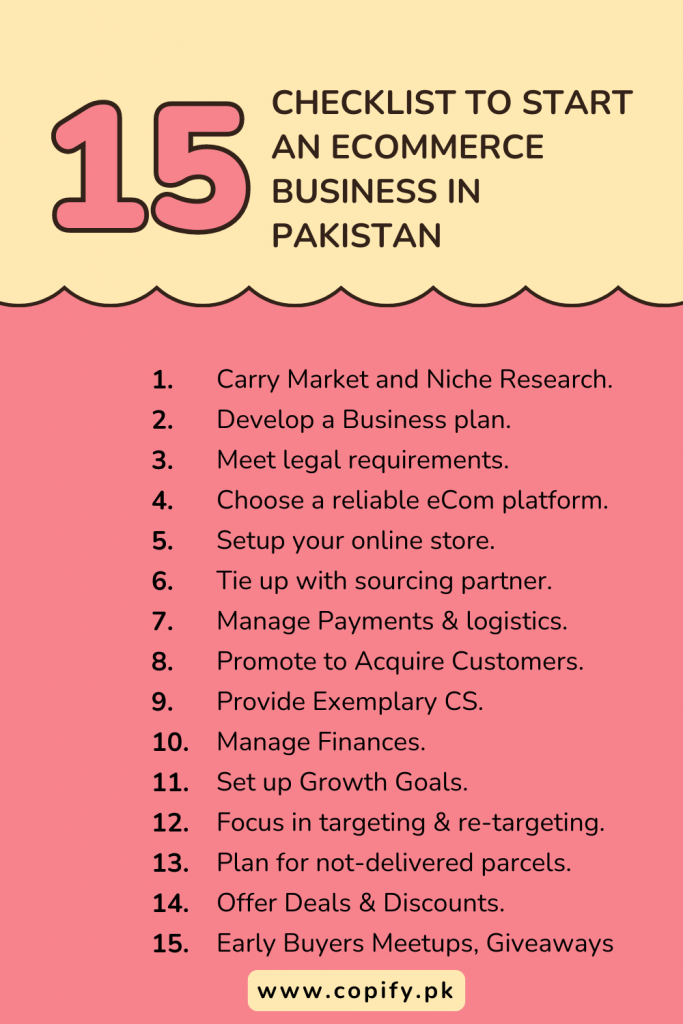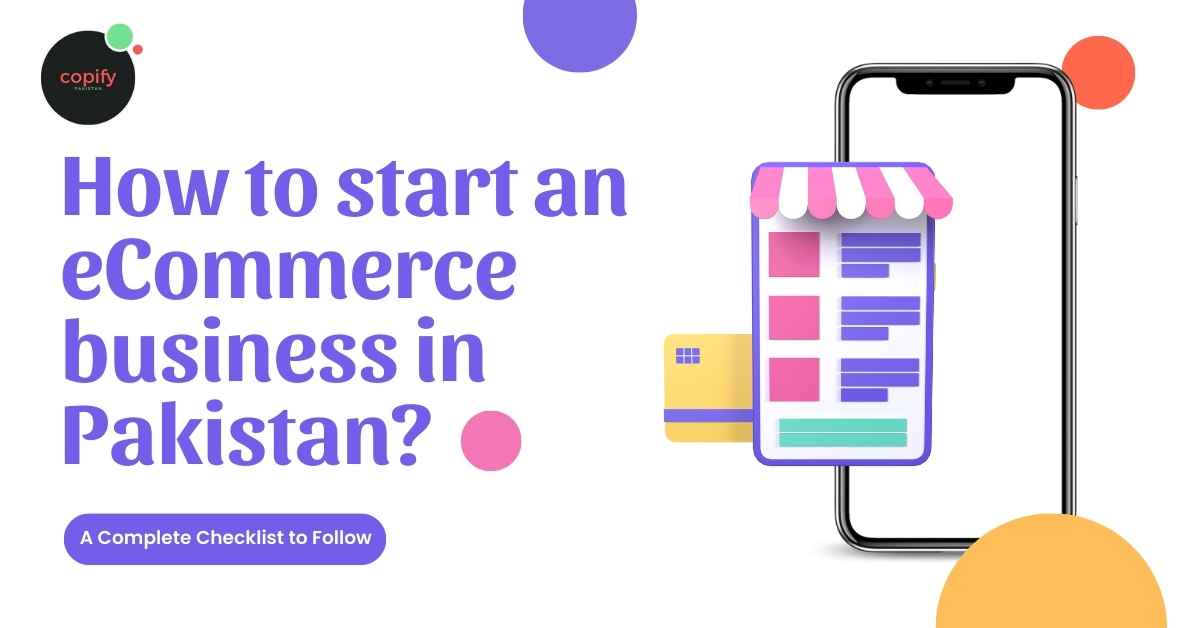The eCommerce landscape in Pakistan has been growing rapidly in recent years. It represents a golden opportunity for entrepreneurs to tap into this burgeoning market. With a population of over 220 million and increasing internet penetration, Pakistan offers a fertile ground for online businesses.
According to ECBD, Pakistan is the 53rd largest market for eCommerce with an estimated revenue of US$2,924.2 million by 2024. If you also want to take your share from the ever increasing eCommerce ecosystem, navigate through this blog.
If you need to know how to start an eCommerce business in Pakistan, this guide is going to walk you through all the essential steps.
A Step-By-Step Guide to Launch an eCommerce Venture in Pakistan
Initiating an eCommerce business in Pakistan offers immense potential. This step-by-step guide provides entrepreneurs with the essential strategies, legal insights, and practical tools needed to navigate the complexities of starting an online business, ensuring a strong foundation for success in this competitive landscape.
1. Market Research and Niche Selection
Before diving into the world of eCommerce, it’s crucial to conduct thorough market research. The Pakistani market is not much populated with eCommerce businesses, which is both an advantage as well as a disadvantage. It can benefit you as few startups may actively be working in the field.
on the other hand, it can put you down in finding enough examples in the market. Mostly, we need to study the existing market players to find what’s selling the most and where lies the gap. Here’s how you can start your research:
- Identify potential niches with high demand and low competition
- Study your target audience’s preferences and buying habits
- Analyze successful e-commerce businesses in Pakistan for insights
- Consider trending products and seasonal demands
Popular niches in Pakistan include fashion, electronics, beauty products, and home goods. However, don’t shy away from niche markets that align with your expertise and passion.
You can choose seasonal products to establish a unique identity. For example, start with a product in skin care with all organic ingredients with relevant certification to grab user trust.
Furthermore, you can come up with unique items in electronics that can prove more efficient than the items readily available in the market.
2. Develop a Business Plan
A solid business plan is your road-map to success. One cannot proceed with a business idea if he or she is not aware of its execution. For execution, you need a hierarchy, where job descriptions and responsibilities of your partners or co-workers are defined.
Add the following elements to your business plan:
- Executive summary
- Company description
- Market analysis
- Organization and management structure
- Products or services offered
- Marketing and sales strategies
- Financial projections
Your business plan will not only guide your operations but also prove invaluable when seeking funding or partnerships.
3. Legal Requirements and Registration
People who start an eCommerce business without meeting the legal requirements soon have to face a downfall. If you are taking it as a business, do it the right way. Pursuing eCommerce with hacks and quick-fixes is a journey that is short-live. To operate legally in Pakistan, you need to:
- Register your business with the Securities and Exchange Commission of Pakistan (SECP)
- Obtain a National Tax Number (NTN) from the Federal Board of Revenue (FBR)
- Register for Sales Tax if you expect to make an annual turnover above PKR 5 million
- Comply with the Prevention of Electronic Crimes Act 2016 and the Electronic Transactions Ordinance 2002
Consider consulting with a local lawyer or business advisor to ensure full compliance with Pakistani laws and regulations.
4. Choose Your E-commerce Platform
E-commerce platform is the backbone of your online venture. Choose a platform that provides you with a simple and easy user interface so that you or an assistant can manage it.
– For beginners: Shopify, WooCommerce, or local platforms like Shopistan or Daraz are among priorities.
– For more control: Custom-built solutions using frameworks like Magento or Laravel. These may require technical expertise and bigger budgets for maintenance and functionality enhancements.
Factors to consider include:
- Ease of use
- Customization options
- Payment gateway integration
- Mobile responsiveness
- Scalability
Hire professional web developers or software engineers to streamline technical operations of your web venture. Pakistan is a flourishing economy in IT exports, which is the reason we have so many software houses working on the latest technologies. You can find more about software houses in detail in our other post.
5. Set Up Your Online Store
Design an attractive and user-friendly website. This should not be limited to making it look attractive but usable as well. In Pakistan, though the eCommerce market is not mature enough so you have to be more careful in displaying calls to action (i.e. Add to Cart, Add to Favorite, View Cart, Checkout). Other factors to keep in mind are:
- Choose a memorable domain name – You can select a word or two from local languages like Daraz, Hamari Dukan, or Cheeni. Or you can go with English names like ShopHive, iShoppping, or Goto.
- Implement a clean, professional design – Ask your designer to follow the theme of minimalism. Keep the design, elements, and buttons simple.
- Organize products into clear categories – Keep the website structure easy to understand. Put products into relevant categories so that a consumer can find a product within 3 clicks.
- Write compelling product descriptions – Meet an expert copywriter or seek help from an AI-powered tool to write persuasive product copies. Focus on highlighting benefits along with key features to make the products stand out from competitors.
- Use high-quality images and, if possible, videos – Try to provide a complete picture despite restrictions of virtual and screen-confined looks. Display a 360-degree overview or upload a professional video of the item.
- Ensure easy navigation and fast loading times – Work on the technical aspects of the site. It is the hosting server, eCommerce platform, and code quality that determines the speed and performance of your store.
Optimize for mobile devices. If your website is not loading well on mobile devices, your website does not exist in the web world. Google is following a mobile-first indexing approach besides considering it a ranking signal. If you are relying on search engines or not, your website must comply with mobile friendliness.
6. Sourcing and Inventory Management
Decide on your sourcing strategy. Check whether you can buy and store the products as it depends on your budget. Or you can follow the dropshipping business model.
Drop-shipping saves you from ordering and managing stock. It requires you to forward all the orders you receive to the vendor, who dispatches it with your branding.
You can look into various options according to your business goal and expansion plans. It can be:
- Local manufacturers or wholesalers
- Import from countries like China (via platforms like Alibaba)
- Dropshipping
Implement an efficient inventory management system to track stock levels, avoid stock outs, and manage cash flow effectively.
7. Payment Gateways and Logistics
Integrate reliable payment gateways. Try to make the payment methods easier. In Pakistan, most of the eCommerce consumers rely on paying cash on delivery.
The Ministry of Commerce reports the usage of Cash on Delivery (COD) 80%, interbank funds transfer (IBFT), internet payment 3%, and wallets and bank deposits around 7% in eCommerce.
You must consider making arrangements for those willing to get items by cash on delivery. whereas, you must also integrate different payment gateways to cater to the customers who prefer to pay online.
- Local options: JazzCash, EasyPaisa, HBL, UBL
- International: PayPal (through Payoneer), Stripe (via third-party services)
For logistics:
- Partner with courier services like TCS, Leopards Courier, or M&P
- Consider cash on delivery (COD) options, which are popular in Pakistan
- Implement a clear return and refund policy
8. Marketing and Customer Acquisition
E-commerce is not a fruitful business if you fail to market it effectively and acquire customers.
The conventional businesses may somehow attract customers just because of its sign boards in busy streets. However, eCommerce is a bit different.
In Cyber World, you will have to pop-up on a mobile or a desktop screen. Grab consumer attention and drag them smooth to website and then to checkout despite so much distraction. You will have to develop a comprehensive marketing strategy. It must include:
- Search Engine Optimization (SEO) for organic traffic.
- Social media marketing (Facebook, Instagram, TikTok)
- Influencer partnerships to acquire more leads.
- Content marketing (blog posts, videos, infographics)
- Email marketing campaigns.
- Paid advertising (Google Ads, Facebook Ads)
Leverage Pakistan-specific platforms like Daraz and PriceOye for additional exposure. Here, you can take advantage of the conventional marketing mediums too.
9. Customer Service and Retention
The success ratio in eCommerce business is determined by customer retention. Most of the people will give your product or service a try for the first time. But making them place orders again depends on your product quality and timely services. You must prioritize customer satisfaction to build loyalty:
- Offer multiple support channels (phone, email, chat)
- Respond promptly to queries and complaints
- Implement a loyalty program or referral system
- Gather and act on customer feedback
- Provide detailed product information and sizing guides to reduce returns
10. Financial Management and Growth
Managing finances is a significant part of the eCommerce business in Pakistan. Initially, you can start receiving numbered orders. It may result in higher expenses and lower profits in the beginning.
Surviving this period depends on your budget and execution strategy. Keep moving forward with every passing day by keeping an eye on your finances.
- Track key metrics (conversion rates, average order value, customer acquisition cost)
- Manage cash flow diligently
- Reinvest profits for growth
- Consider seeking investment or loans for expansion
- Stay updated with e-commerce trends and continuously improve your offerings.
Challenges and Considerations
Be prepared to face some challenges unique to the Pakistani market:
- Limited digital payment adoption (hence the popularity of COD)
- Trust issues among consumers regarding online shopping.
- Logistics challenges in remote areas.
- Higher return rate in parcel deliveries.
- Uncertain price hike of supplies affecting costs and profits.
- Increasing competition in the e-commerce space.
- No feedback or appreciation from customers.
Conclusion
Starting an eCommerce business in Pakistan requires careful planning, dedication, and adaptability. By following these steps and staying attuned to local market dynamics, you can position yourself for success in Pakistan’s growing digital economy.
Remember, success doesn’t come overnight – be patient, stay persistent, and continuously learn from your experiences and customer feedback. With the right approach, your eCommerce venture can thrive in this exciting market.




